Part 2 of an occasional series. Rings in my Etsy shop that remind me of things …
Part 1 was a ring that reminded me of an Iron Age hillfort …
UPDATE: 28 October 2015 – the ring has now sold. Sorry!
Part 2 of an occasional series. Rings in my Etsy shop that remind me of things …
Part 1 was a ring that reminded me of an Iron Age hillfort …
UPDATE: 28 October 2015 – the ring has now sold. Sorry!
I should be working this morning, but I have lost it to the partial solar eclipse. Where I live we had about 86% coverage at the maximum of the eclipse. It got very cold, and the birds started to roost in the trees. Our cats were also out of sorts, running around and behaving oddly.
Here’s the procession of the eclipse, as photographed on my not-very-good camera:
I also had the telly on, watching Eclipse Live with Professor Brian Cox and Dara Ó Briain, and they showed live footage of the total eclipse as experienced in the Faroe Islands—with a glorious diamond ring on the way out of the totality of the eclipse.
I also happened to snap some pics of the telly feed just as they were changing from a shot of Stonehenge (about 15 miles from where I live) to a closeup of the sun there, and got this amazing image:
Very science fiction!
The total solar eclipse of August 1999 was a bit of a wash-out here, as the cloud cover was so heavy I saw nothing of the sun. So even though it was a cloudy day here, it was great to see so much of the eclipse.
Look at this beauty! Chap was given it by a friend the other day. It’s a huge nautilus-like ammonite. Our friend is another historic building conservator, and found the fossil in a weathered and degraded stone that she had to remove from an old building in Sherborne, in Dorset, in order to fit a replacement piece.
The stone is almost certainly Sherborne Stone, a limestone which was quarried close to the ‘new’ Sherborne Castle, and the quarries have been recently reopened. According to the quarry’s website, Sherborne Stone dates from the Bajocian age of the Middle Jurassic, and Wikipedia tells me that the Bajocian lasted from 171.6 to 167.7 million years ago. Looking at the list of ammonite species known to have lived in that near-four million year period, I don’t think I’m going to easily identify it, which is a shame. I’d love to know which species it is.
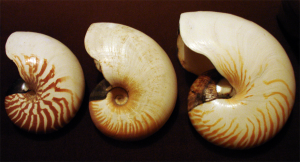
The shells of three present-day nautilus species. Left to right, Nautilus macromphalus (left), Allonautilus scrobiculatus (centre), Nautilus pompilius (right). Photo by User:Mgiganteus1.
Chap and I love looking for fossils. Part of our work in archaeology back in the early 90s involved a lot of fieldwalking (or Surface Artefact Collection, as it later became known)—an archaeological surveying technique that seems to have gone somewhat out of favour (it’s very time and personpower-heavy). Essentially it involves walking line transects spaced at set distances up and down ploughed fields, and picking up everything of archaeological interest, so the distribution of various artefact types and densities can then be plotted. This may be an indicator of below-soil archaeological sites and features such as pits and ditches that have been disturbed by ploughing, activity which has brought the artefacts to the surface. Anyhow, a lot of our fieldwalking was around the Wessex region and so on chalk geology, so we would also find many fossils, mainly echinoids (sea urchins). As these aren’t of archaeological interest, we got to keep them. So we have a great collection of lovely fossilised sea urchins. Even now, when we go for a walk, old archaeological habits die hard and we’re usually scanning the ground for flint flakes and pot sherds (and of course fossils) rather than looking at the view …
The markers of spring are gradually accumulating: the first snowdrops, the first honeybee, the first chaffinch with its fluting descending spring call, the first beetroot red shoots of the paeonies. I took some photos the other day of the wonderful drift of Cyclamen coum flowering on a neighbour’s bank.
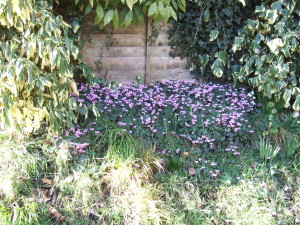
Cyclamen coum on a neighbour’s bank. These self-seed freely, from seedpods with fantastic coiled stems.
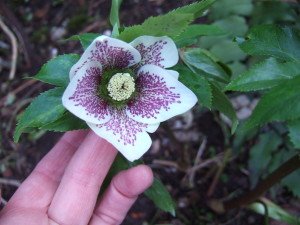
A speckled Helleborus orientalis in my garden. I’m holding the flower up as it normally hangs down so you can’t see the glorious interior.
I adore this season, with its sense of promise and renewal.
An occasional series on gardens I have designed and planted. First up is a garden in Devon, made for my younger sister. In 2001 she moved into her present home, a Georgian house with a small, sloping, south facing stone walled garden at the front. Her brief was ‘jungly, exotic, subtropical’. She loves acers, hostas, bamboos and ferns in particular. She wanted a garden full of foliage interest: different shapes and colours and textures, and the bigger the better. Flowers weren’t the top of the list, but if they were to sneak in there, she wouldn’t mind …
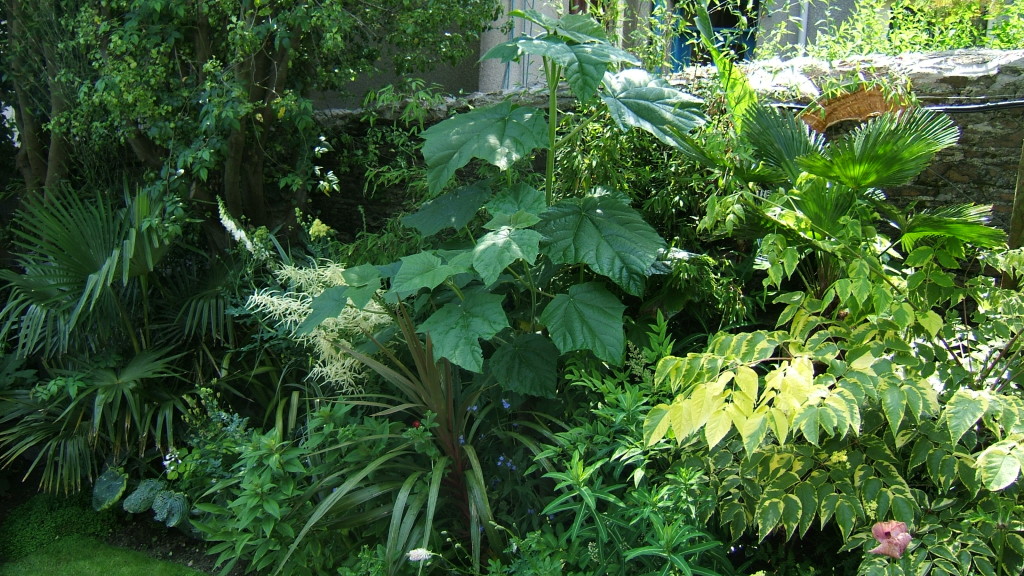
The main emphasis in the garden is on the foliage. The large-leaved plant is a Paulownia tomentosa which is cut right back every year to encourage the large leaves to grow. Other plants seen here include Aralia elata ‘Aureovariegata’, Euphorbia mellifera, Nandina domestica and Aruncus dioicus. There’s a banana lurking in the background too.
The garden had a few mature trees around the edge and a grand old apple tree on one of the terraces: everything else was old or diseased or unwanted, and so they went, leaving a daunting area of naked ground. After the cull, the first thing we had to do was weed, weed and weed, and then weed some more, and then leave the garden fallow for a whole year before we could plant anything. The reason? Ground elder (Aegopodium podagraria). It was everywhere in the garden, its roots reaching sometimes 50 or 60 cm deep, and getting into the stonework of walls and under the paths. The trouble with ground elder is it is highly invasive, smothering out other plants, and it can regenerate from the smallest fragment of root left in the soil. So we dug out as much as we could, and then waited to see what sprouted, and gave it another digging over. We preferred to do the weed control manually and organiicaly, rather than go the quicker chemicals-based route of zapping the lot with weedkiller.
After over a year, in spring 2003, we were able to start planting. The hard landscaping for the garden wasn’t too attractive, but it was too big (and expensive) a project to redo it as well as completely replant the garden, so we made do. We were lucky in that the garden was completely surrounded by a beautiful old stone wall, made from the local Devonian shillet.
My sister decided she wanted an alley of pompom trees (as we inelegantly call them) to flank the central path up to the house. We planted eight magnificent Elaeagnus x ebbingei trees from Architectural Plants in West Sussex. On either side of this I planted matching jewel beds that were inspired by the beautiful show-winning Evolution Garden by Piet Oudolf and Arne Maynard that I’d seen at the Chelsea Flower Show in 2000.
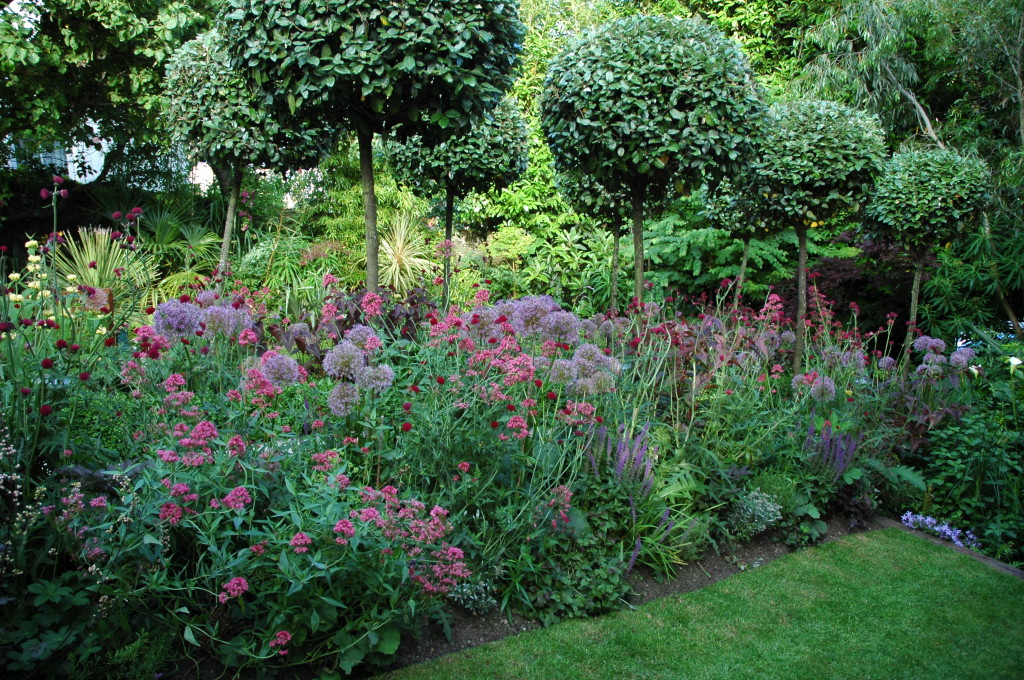
The jewel beds, with Allium ‘Globemaster’, Cirsium rivulare ‘Atropurpureum’, Veronica austriaca subsp. teucrium ‘Knallblau’, Veronica spicata ‘Romiley Purple’, Convolvulus cneorum, Centranthus ruber var. coccineus, Persicaria microcephala ‘Red Dragon’, Alchemilla mollis, and others underneath the eight Elaeagnus x ebbingei trees.
We made a pond, and a tree fern grove underplanted with ferns, and shrubby beds at the bottom end of the garden to provide some privacy from the street.
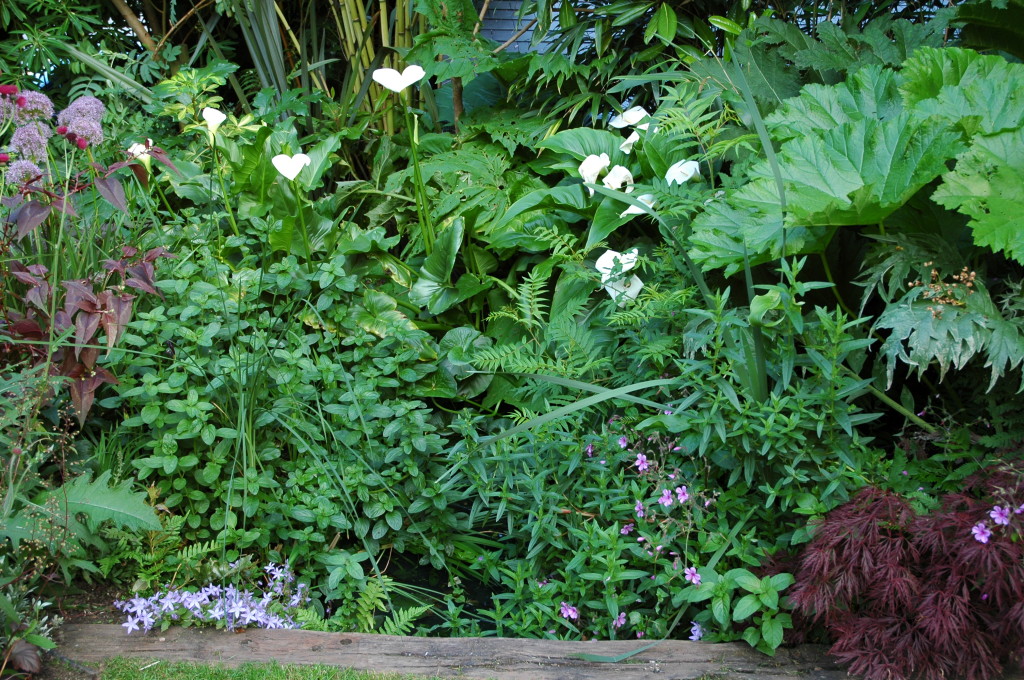
There’s a pond in here somewhere, honest! Plants include the massive Zantedeschia aethiopica ‘Gigantea’, Arundo donax, Darmera peltata, Cynara cardunculus and good old Geranium palmatum that self-seeds with wild abandon.
My sister opened the garden for a weekend in the end of May for three years (2005, 2006 and 2007) for the National Gardens Scheme: all moneys collected go to various charities, and over the three years she raised a truly amazing £3,300 from entrance fees, the sale of cakes and refreshments, and in the second and third years we ran a plant stall as well as so many people were asking for plants that were in the garden. I started potting up all the Echium pininana seedlings I could find, plus Geranium palmatum ones and splitting off bits of the Cirsium rivulare ‘Atropurpureum’ and potting on as well. They all went like hot cakes!
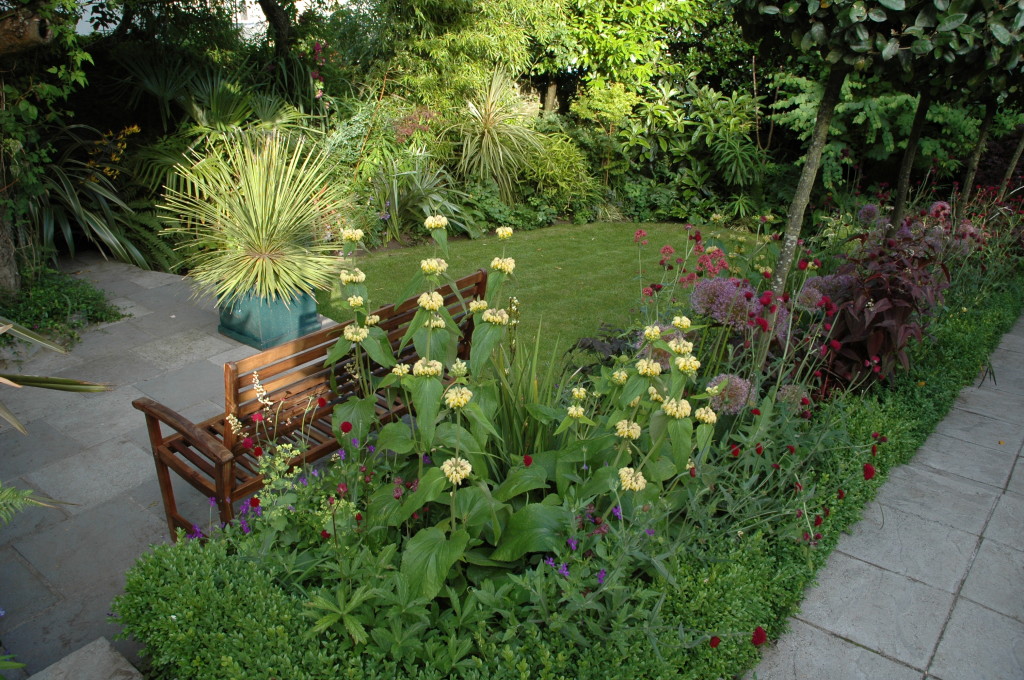
The central jewel beds edged in box (Buxus sempervirens). The yellow plant is the lovely but thuggish Phlomis russeliana. The amazing plant in the pot on the terrace is Dasylirion acrotrichum.
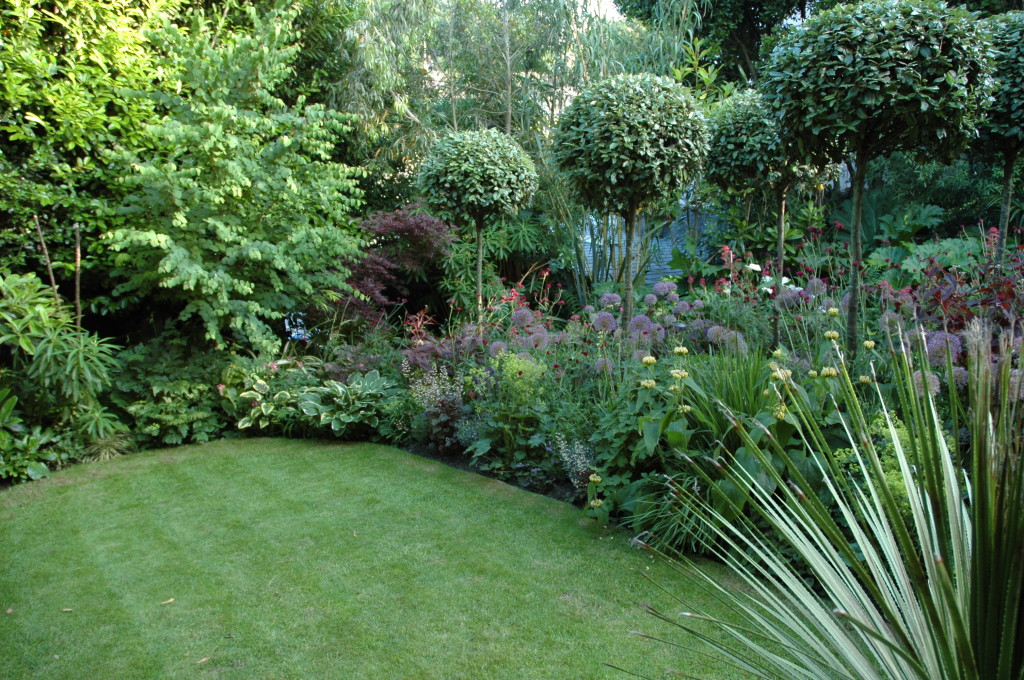
The left hand lawn surrounded by shrubs and trees including Cercidiphyllum japonicum (Katsura, a tree that smells of candy floss in the autumn when the leaves are colouring up), Euphorbia mellifera, with flowers that smell of honey, and Melianthus major, with leaves that smell like peanut butter when bruised and flowers that smell like honey! The Allium ‘Globemaster’ heads are just going over in this photo.
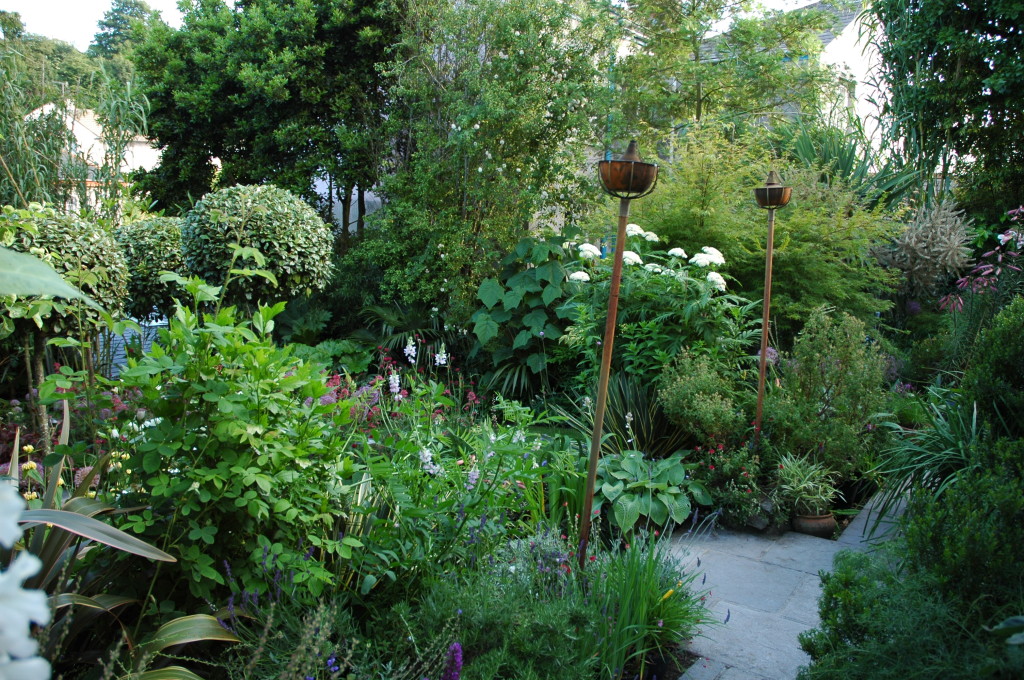
View from one of the top terraces looking across the garden.
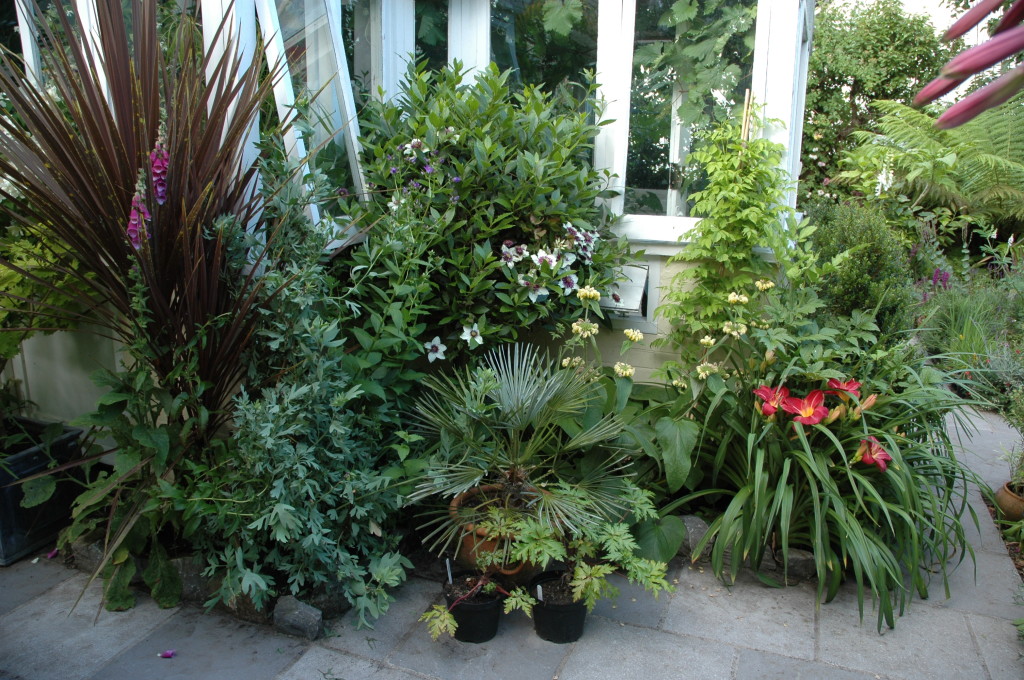
Lots of pots everywhere, including beautiful fragrant Lilium regale looming in on the right.
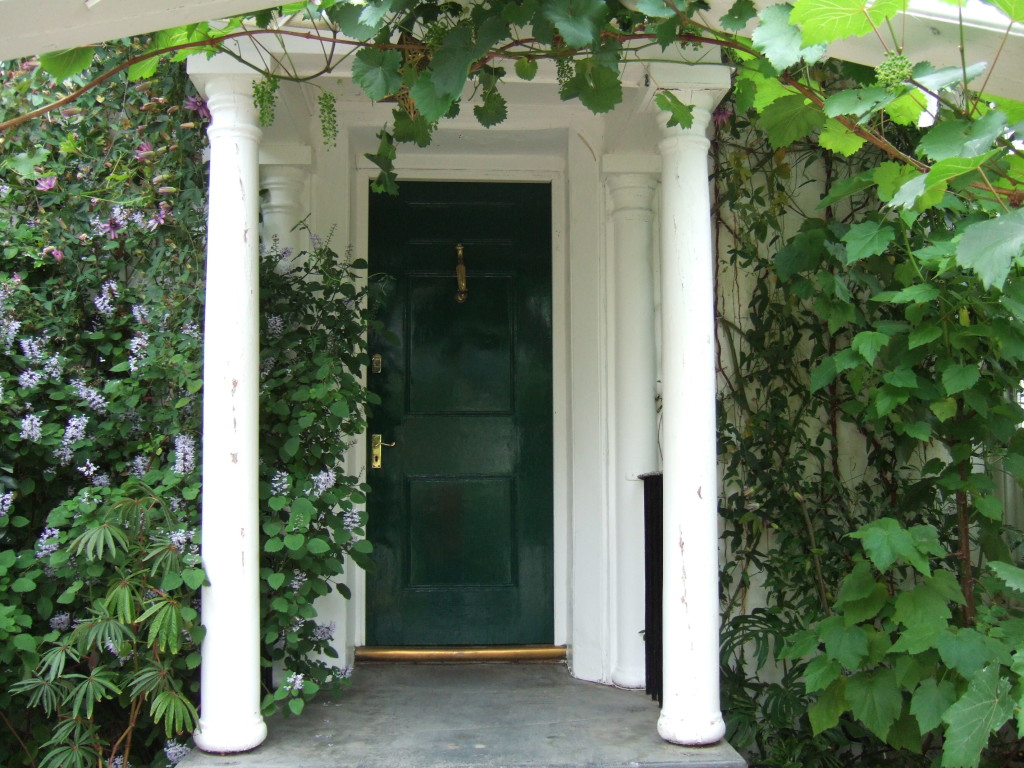
The conservatory. This is an Edwardian addition to the front of the house, and is a beautiful, restful space. The pale blue flowered plant is Plectranthus zuluensis, with a pinky purple-flowered passion flower growing above it, and of course there’s a grape vine.
This little cloisonné enamel brooch caught my eye: the colours are beautiful, as is the design. At first I wondered if it might be an imperial eagle of some sort (not the Russian one, as that has two heads), but perhaps a generalised version, as it appeared to be holding a royal orb in either clawed foot.
I love the beautiful way the wing feathers are depicted, and the triangles to represent the bird’s speckled breast. Taking a closer squint I noticed the ‘breeches’ on the bird of prey, and realised it is a hawk or falcon of some sort. And then it clicked: the ancient Egyptian god Horus was depicted as a falcon. Talk about the proverbial lightbulb switching on …
So off I head to do a bit of poking about on the web, and come up with this wonderful object:
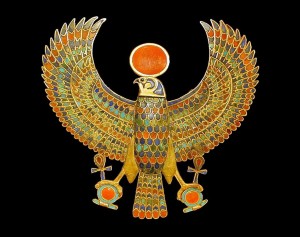
One of the treasures of King Tutankhamun’s tomb: Horus / Ra-Horakhty jewel. Photo by Jean-Pierre Dalbéra (check out his flickr stream: it’s amazing!)
My little brooch is based on this design, or something very similar to it. The beauty above was excavated in 1922 from the Tomb of Tutankhamum, apparently, though I have struggled to find out much more information than that. I assume it is with all the other King Tut treasures in the Egyptian Museum in Cairo, and was hoping to search their collections database online, but sadly the website for the museum is under construction at the moment. I have the 1972 guidebook to the British Museum Treasures of Tutankhamun exhibition, and it is not shown in that, so maybe it didn’t come over here for the exhibition.
(A small aside: I visited the exhibition with my family when I was nine. We queued outside the Museum for hours and hours, but luckily the summer weather was sunny and there were plenty of ice cream vans nearby. I was so excited to see the famous mask that I scurried through the rest of the exhibition, only to be dismayed when I had looked at the mask—the final artefact in the display—and then tried to go back to see the rest of the exhibits (and find my family) that the guard refused to let me back as the exhibition had a ‘one way’ policy to avoid clog ups. I was gutted and so annoyed at myself and my impetuosity. One day I will make it to Cairo to have a proper, long look at everything.)
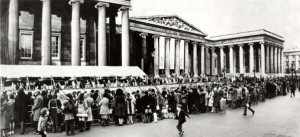
Queues at the British Museum to see the Treasures of Tutankhamun exhibition, 1972.
Horus was the Ancient Egyptian god of the sun, war and protection, and was usually portrayed as a falcon or as a man with a falcon’s head; by later Dynastic times he had merged with another sun god, Ra, whose symbol was a sun disc, to form Ra-Horakhty. The sun disc above the falcon’s head suggests this is thus a depiction of Ra-Horakhty. The round objects that Ra-Horakhty is holding in the Tutankhamun object are shen rings, which signify eternal protection, and above them are ankhs, which represent eternal life.
The Horus / Ra-Horakhty falcon on my brooch is missing the sun disc above its head, and the configuration of the ankhs and the shen rings have become a little confused so they look more like royal orbs, but this may well be due to the western artist’s lack of familiarity with the symbols and iconography of Ancient Egypt.
I wonder which member of the falcon family (Falconidae) is depicted on the Tutankhamun specimen. The speckled breast and eye markings are very distinctive, similar to those found on some hobbys, merlins and falcons. I’m sure someone has done research into to species of animals portrayed in Ancient Egyptian art. There’s quite a list of possibles from which to choose, although many of the species listed just winter in Egypt and breed elsewhere, rather than being year-round residents.
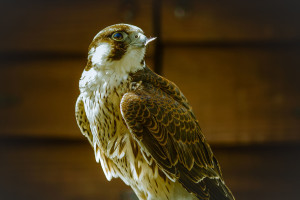
Barbary falcon (Falco peregrinus subsp. pelegrinoides), a subspecies of Peregrine falcon. Photo by Jason Halsall.
I wonder if the Barbary falcon (Falco peregrinus subsp. pelegrinoides) is the most obvious candidate, as it is a subspecies of the Peregrine falcon, the fastest animal on earth, and one which has been admired for thousands of years for its speed, grace and hunting prowess.
Since Chap and I moved to our cottage 22 years ago, we have kept a nature diary. We record what’s going on in the garden, what wildlife we have seen, what the weather is doing, and general impressions of the natural world about us. We have a bird species list, where we note ‘new’ birds when we see them in or over our garden.
Yesterday morning I was chatting to Chap on the phone, looking out of the study window as I always do when I’m on the blower (my desk faces a wall so it’s nice to see the world …!), when I had a wonderful, chance surprise. A heron was flying towards our cottage, not very high at all and coming right at us. It is the first time I have ever seen a heron here (though there are some on the nearby streams and rivers and lakes). I squealed down the phone at Chap and near-deafened him, I think.
It flew right over me and I had a great view of its belly as it passed. Beautiful.
Herons (Ardea cinerea) are such wonderful birds. We sometimes see them standing stock still in the local shallow chalk streams, poised and ready to strike, or walking with that slow, high-stepping tread through the water. They are a beautiful cloudy-sky grey. But it is when they are flying that they intrigue me most, and remind me of nothing more than the illustrations of flying pterodactyls in my dinosaur books from my childhood. Watching a heron fly you can quite easily believe that birds are feathery dinosaurs … Their heads are pulled back, their legs trail behind them and they beat their enormous wings with slow, steady flaps.
Their wingspan is among the largest of British birds, at between 155 and 195 cm for an adult bird.
(I know their proper title is Grey heron, but they are just ‘herons’ here as we don’t have any other type here in the UK—and they are, after all, the original bird to be called a heron).
Such an exciting day. But I think of all our heron sightings, the top one still has to be the day we saw a buzzard (Buteo buteo) and a heron having an aerial dogfight. We used to live in the Woodford Valley north of Salisbury, and were driving close to Lake House when we saw a tussle going on in the sky, just above the trees by the road. The two birds were circling round and round each other and occasionally clashing, and as they are both large birds it was quite a spectacle. We couldn’t quite make out what was going on, but we wondered if the buzzard was harrying the heron to make it regurgitate its catch.
PS. Our lone fieldfare is still with us, 36 days+ and counting. We had some snow the other day—not deep, but enough to remind him of home.
UPDATE Saturday 6 May 2017: This morning we had only our second ever sighting of a heron from our house in the near-twenty five years that we have lived here. And what a close encounter it was: it flew its slow flapping flight very low over our neighbours’ garden, and to our amazement landed in a very ungainly fashion on an overhead line just above the garden. It stayed perched there for about a minute or so before flying off. I hurried to look at our garden to see if it was heading for our pond, but sadly no – although I should be grateful that the tadpoles and newts and frogs live to see another day. Seeing such a massive bird perched on a wire was quite a thing.
I love enamel jewellery. Here are the enamel pieces for sale in my Etsy shop at the moment:
And despite the fact that orange is my favourite colour, it seems curious that every single piece of enamel jewellery I have in stock is either blue, green or white (with just a tiny hint of other colours in the fruit and flower basket brooch, the Horus brooch and the pansy brooch).
Hmm, I think I’m going to have to go on a zingy colours spending spree!
A vintage modernist moonstone and sterling silver ring:
Cadbury Castle, Somerset, an Iron Age hillfort, as drawn by William Stukeley, 15 August 1723:
As an archaeologist, I tend to see archaeological-related shapes everywhere: the ripples in a pond are the conchoidal ripples on the ventral surface of a flint flake; the tarmac repair in a pavement over a service trench is a prehistoric ditch, waiting to be excavated; the fruit and nuts in Cadbury’s Fruit and Nut Chocolate are the inclusions in coarse Bronze Age pottery (okay, maybe I’m getting a bit carried away here …)
So it’s no great surprise I suppose that when I saw this ring, the first thing I thought of was the famous Stukeley engraving of Cadbury Castle (which he called Camalet Castle: it’s near the villages of West Camel and Queen Camel, and local tradition holds that it is the site of King Arthur’s Camelot). I have a copy hanging in my study and love it very much.
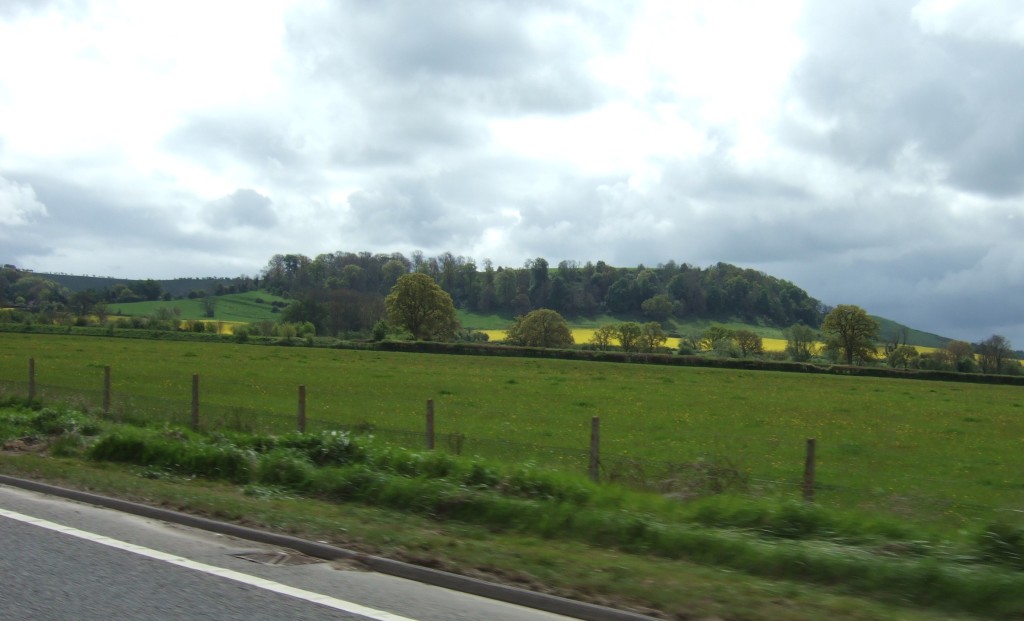
Cadbury Castle, photographed from the A303. The enormous earthworks show up much better in the winter, when there is no foliage on the trees. As you can see, there is some artistic licence in the Stukeley version of this view … 26 April 2009.
I drive past Cadbury Castle frequently, as it is just to the south of the A303. I remember as a child being taken to the excavations there one summer when we were holidaying in the south-west, and the Iron Age body sherds were being sold for 3d a piece (I think it was) with a sign saying the proceeds would go to the diggers’ beer fund. I bought a couple of sherds and they were my treasured possessions for a long time. Until I lost them, and promptly forgot about them, as kids do.
It’s a great spot for a walk too, and always very empty of people. There is a terrific view of Glastonbury Tor from the hillfort.
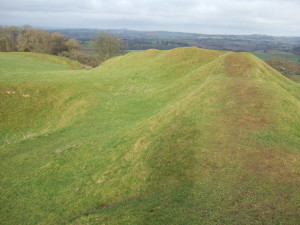
Cadbury Castle. View from the top of the ramparts (Glastonbury Tor sadly out of shot). 24 January 2010.
And as for the ring, it’s for sale in my Etsy shop.
UPDATE: 18 March 2015 – the ring has now sold. Sorry!
LATER UPDATE: This became the first in an occasional series on my blog, titled ‘Rings that remind me of things‘.
Every year since 1979, the Royal Society for the Protection of Birds (RSPB) has asked people across the UK to spend an hour recording the birds they see in their garden: the Big Garden Birdwatch. The results are used to provide a snapshot of the bird life in our country, and to work out which species are in trouble and in need of help. The census is billed as the world’s largest annual wildlife survey, and last year nearly half a million people took part (not bad in a country of 64 million people), counting 7,274,159 birds. This year’s event took place over the weekend of 24—25 January, and we spent an hour on Sunday morning doing our bit.
Chap and I take part every year, and I love the enforced stillness that an hour spent at the window watching and counting birds brings (Chap covers the front of the house and I look out of the back). An extended period of observation allows you to see things you might not otherwise have noticed, such as the several times I saw a blue tit (Cyanistes caeruleus) and a great tit (Parus major) flying, perching and then flying on together, very much a twosome;
or the male blackcap (Sylvia atricapilla) feeding on the windfall apples—I have never seen this behaviour before (in fact, I have never seen a blackcap on the ground before), and always assumed they were insectivores rather than being fruit eaters as well. I saw two male blackcaps hanging around together, and wondered if they were perhaps part of a sibling or family group, or if simply male blackcaps aren’t very territorial (in contrast, the robins in our garden are forever chasing each other off), and later I saw a lone female. I hope they meet up and there’ll be lots of baby blackcaps this summer!
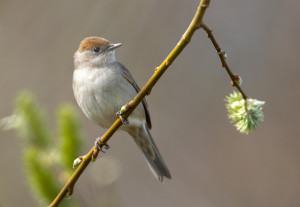
Female blackcap. Photo by Chris Romeiks (Vogelartinfo on Wikimedia Commons).
I was also really pleased to be able to add fieldfare (Turdus pilaris) to the list for the first time, as our Scandinavian guest is still with us. We first noticed him on 29 December last year, though he may well have been around before that, and since then he has been assiduously guarding the windfalls from his perch on the apple tree above them, or from one of the surrounding higher beech trees.
Of the more unusual birds we see, no siskins (Spinus spinus) or bullfinches (Pyrrhula pyrrhula) or bramblings (Fringilla montifringilla) this year, which was a shame.
Last year for the first time we were asked about other wildlife in our gardens too, so we were able to enter information about the frogs, badgers and hedgehogs that we have seen, as well as other animals.